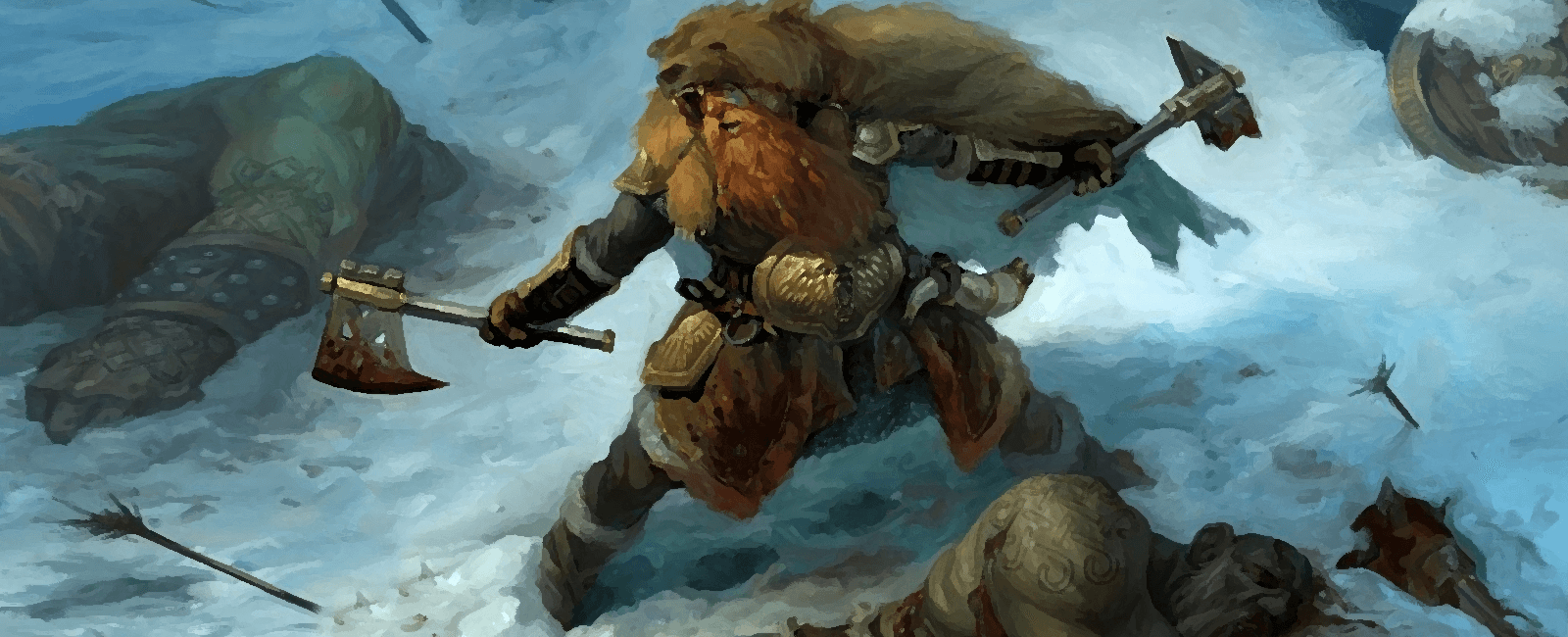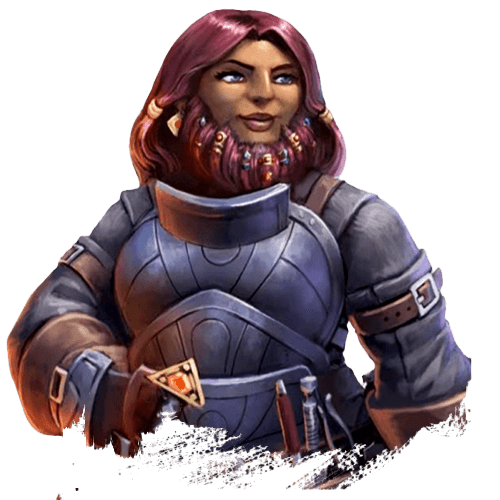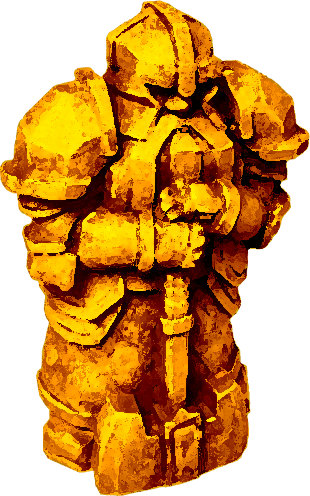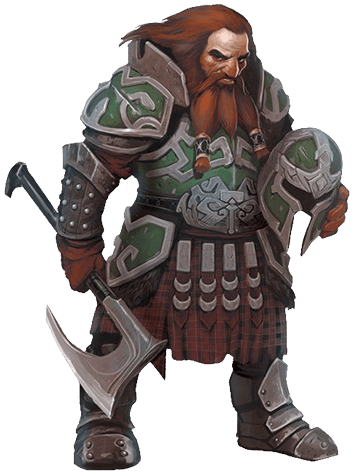Dwarf
"How can you tell a human just became a dwarf's best friend? The human has recently died of old age and the dwarf is attending their funeral."
Dwarves, sometimes called Durin's Folk, are a race of Durinian ancestry common in virtually all parts of Edora. Throughout history the dwarves were known as a tough, unchanging and tradition-abiding folk, possessing strong and advanced martial traditions and master craftsmen, both in war and in times of peace.
Basic Information
Anatomy
Dwarfs are the bulkiest of the durinian species. Despite being shorter then humans they weight about same, with most of the weight attributed to their dense and extremely though muscle tissue. The height of a dwarf depends mostly on their ancestry with gold dwarves being the shortest and shield dwarves being the tallest.
Genetics and Reproduction
Like all durinian races, dwarves do not reproduce by normal biological means. When two dwarves form a bond of unbreakable trust and friendship, half an iron statue manifest in their dwellings, with their counterpart receiving the other half. Those parts can be forged together into a single statue, forming the heart of the newly forged dwarf.
Dwarven parents will forge, detail and add layers upon layers of different metals and minerals to the statue. On each layer they will carve the story of their lives and of their families, teaching the statue their language, history and traditions. After 10-12 years of forging and detailing, when the statue becomes approximately half the size of an adult dwarf, it wakes into life as a dwarf. The new dwarf will recognize his parents, speak their language and know their familial lineage to some extent.
This process can occur even between dwarves of the same gender. This occurrence is rare but usually happens between two dwarves that shared a strong experience. Such experieces can most often be sumed as 'surviving together against all odds', but friendships between members of feuding thaigs are also a common cause. Offspring of those relationships are called 'Avatars' by dwarven traditions. Their memory is often much longer and accurate from others of their age. Some avatars had shown the ability to recall nearly all the memories of their ancestors, from both sides and up to several centuries past. Acording to dwarven traditions those who are born as avatars are believed to be a direct intervention by Durin to help guide his people. The Archivists of both Dam Lodir and Dam Tarihr actively seek these young dwarves to help piecing together their lost race history and bridge the gap between the two kingdoms.
Growth Rate & Stages
Dwarves are a relatively long-living race. They reach physical maturity somewhat later than humans, around the age of 25. A dwarf is traditionally considered an adult once they reach age fifty. Dwarves can remain vigorous well past 150 years. Most dwarves lived to see their 200s with few even living to be over 400 years old.
Additional Information
Facial characteristics
The easiest way to recognize a dwarf is the thick and usually well groomed beard as even some females sport them. Beards for dwarves are more than just facial hair and the connection runs even deeper than traditions or culture. A dwarf's facial hair is different than that of all other sapient ; it is comprised of both regular hair and specialized fibers that collect dust and filters the air the dwarves would otherwise inhale while digging or tunneling deep underground. Traditionally, female dwarves will not work in mines but care for their houses or family business instead. Regarding the beards, a female's beard is more a matter of prestige and personal statement; they usually shave their beards if they venture outside of their kingdoms for prolonged periods of time, to avoid being seen as "strange".
The first time a dwarf has to shave their beard is considered a traumatic and sad event, even if it is done for the sake of trade or business. It is customary to have a lavish meal and get completely drunk before the act, and to never speak of it ever again once it's done. Making a comment of a dwarf's lack of beard, male of female, is considered one of the most hurtful and rude things an outsider can do, and such acts are rarely forgiven.
Geographic Origin and Distribution
Most dwarf on Edora reside across the Amadel Mountains, both on its peaks and underground. These dwarves are set into two seperate kingdoms, Dam Lodir in the Northern Amadels and Dam Tarihr in the Southern Amadels.
Outside of the Amadels, dwarves can be encountered almost anywhere with large and proud communities spread around the big cities. Dwarves are only second to humans in their far reaching distribution. Some dragonborn claim dwarves existed on Ebbir as well, and while depictions of creatures simillar to dwarf in shape an size do appear in their scriptures, no dwarves have been known to cross with the horde to prove these claims.
Perception and Sensory Capabilities
Dwarves have a unique connection to stone they refer to as stonecunning. This connection allows them to identify and examine stone, soil, gems and sand for quality, mineral composition and even magical effects and history to some extent. The usage of this ability is described as being "told a very long story by something that speaks slowly." Some dwarves describe the experience as similar to a hunter being able to track pray by smell and marks, though it doesn't need to be, and the ability can not be taught. All the dwarves sub-races are known to posses this sense.
Dwarves also posses a very long and accurate memory that gets even longer and sharper as they age. A century after being forged, a dwarf can concentrate on an event with such focus that it is etched to his mind with perfect clarity until their death. The first time this occurs, the dwarf is considered to have completely lose their youth and are past their prime. Even At younger ages some dwarves can already recall their last few hours with perfect clarity. This trait is thought to have been developed to accommodate to the dwarves life underground, having to navigate tunnels and mine shafts; the fact that gnomes also possess a similar, yet somewhat less defining, trait, supports this notion.
Civilization and Culture
Gender Ideals
While at a first glance dwarven societies seem to be patriarchal, this is only the case in politics; within each family the real power is the matriarch's. While dwarf males serve as societal leaders, wage war, trade, and craft, and essentially any other role that requires constant engagement with other races. Females serve as house leaders, overseeing all their house political connections and internal relationships; matriarchs are almost venerated for their wisdom and intellect. A house's matriarch is also in charge of all her offspring education and teaching, ensuring they go on to fill their role in the clan's, and the matriarch's, grand scheme of things.
Relationship Ideals
Dwarves put great value on the ties between family members and friends, weaving tightly knit clans. Dwarves particularly respect the elderly, from whom they expect strong leadership and the wisdom of experience. This idea carries on to relations with other races and dwarves who venture out of their clan will mostly respect and honor even the elders of another, non-dwarven race.
Being instrumental to their species reproduction, dwarves view friendship as a sacred ritual. Even a small dishonesty can tarnish the relationship between two, seemingly good friends forever. For dwarves relationships are based on trust that builds over many decades. A dwarf will usually refer to someone as a friend after knowing them very well, and for over five or six decades.
Common Taboos
Considering trust is essential for their race survival most dwarves view lies, betrayals and treason as insult not only to them, but to the earth and the gods as well. Dwarf don't differentiate between a vow and a simple task, and to break a promise or not deliver the expected result is mostly viewed as a disgrace on the promising party. Dwarven trade is a volatile occupations where even a small dishonesty in a deal may be taken as provocation, and a rightful cause, for war. For this reason, dwarven kingdoms and communities rarely let anyone but official, trained and licensed merchant to trade and barter with non-dwarven races.
History
Like many races, the exact origins of the dwarves were lost to myths and legend. While many non-dwarven scholars argue that dwarves were not native to Edora, most dwarves believe that their ancestors came from the core of the plane itself, seeded as small iron sculptures by the Titan Durin. According to these legends the dwarves fought their way through the Underdark and into the surface world, overcoming the dangers they faced below through strength of arms and sheer competence.
Ever since they surfaced the dwarves have built mighty kingdoms, covering the entire Amadel Mountains with settlements and fortresses, even expanding below the mountains where their abandoned ruins still stand the tests of time. The first dwarven kingdom was Mes Boldahr but almost all records of it have been lost in the wake of the Battle of the Second Sun, which toppled the mighty dwarven bastions.
After the The Days of Reckoning, the two surviving dwarven kingdoms of Dam Lodir and Dam Tarihr both tried to reclaim their lost Deep Roads. However, the damage was so extensive it took centuries for the two kingdoms to reconnect; Even then, the isolation of the two has created several differences in their cultures, the most problematic of those being the changes made to the Dwarven Saga while they were separated. Neither kingdom is willing to accept the changes made by the other, as they would damages the continuity of the song. The disagreement even led several times to armed conflicts.
Current Date: 2nd of Latsum, 1572
Genetic Ancestor(s)
Scientific Name
T. Anima Robustus
Lifespan
350 years.
Average Height
4–5 ft (1.2 – 1.5 meters)
Average Weight
160–220 lbs (73–100 kg)






Comments